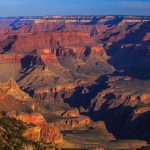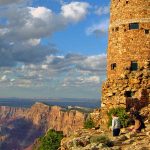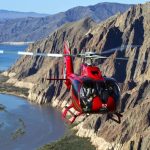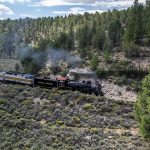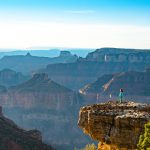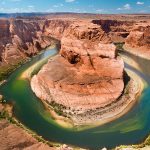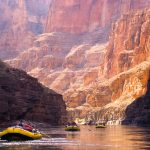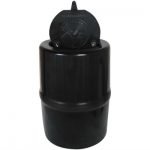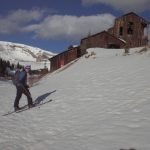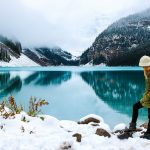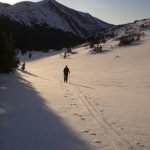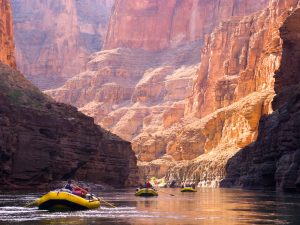 I’ve often heard people wonder why they should want to go to the Grand Canyon, “It’s just a crack in the earth right? Cool.” The funny thing is though, you’ll never hear that from someone who’s explored the Grand Canyon. Once you’ve been to the top and looked down onto the Colorado, gone from North Rim to South Rim, or even spent a couple of minutes pondering the power of Mother Nature while gazing down on her masterpiece, you’ll never think of the Grand Canyon as “just a crack” ever again.
I’ve often heard people wonder why they should want to go to the Grand Canyon, “It’s just a crack in the earth right? Cool.” The funny thing is though, you’ll never hear that from someone who’s explored the Grand Canyon. Once you’ve been to the top and looked down onto the Colorado, gone from North Rim to South Rim, or even spent a couple of minutes pondering the power of Mother Nature while gazing down on her masterpiece, you’ll never think of the Grand Canyon as “just a crack” ever again.
Looking over the Grand Canyon is kind of like looking over an ocean. You automatically feel a little bit smaller, and realize that the world is a little bit bigger than it feels sometimes. Moments like that put life into perspective a little, and there are few better places to just sit in awe of life and the world around us than Grand Canyon National Park.
—- About The Park —-
Of course, the first thing you’ll notice upon arrive to the Grand Canyon, is the grandness of the canyon! Almost unfathomably large, the scene leaves no doubt in your mind regarding the power of the Colorado River and a little bit of time. The Grand Canyon features 277 river miles, a width of up to 18 miles, and a depth of one mile at places. Each year roughly 5 million people behold this Natural Wonder of the World, making tit the second most visited National Park, behind Great Smoky.
The length of the Canyon leads to a striking difference in weather between the North and South rims. The South Rim is open year round, as opposed to the North Rim (roughly 1000 feet higher) which closes seasonally, and with large snow falls. Fewer people see the North Rim, as it is 220 miles by car, and 21 miles by foot from the South Rim.
Historically, southwestern Native Americans have inhabited the Canyon and the surrounding territory, with the Spaniards being the first Europeans to discover it. The Spaniards explored the Canyon and surrounds looking for gold and the Seven Cities of Cibola, although they were fast to abandon this search. Eventually, as the Mormons headed West, Brigham Young sent followers to search the area and establish passes such as Lee’s Ferry and Piece Ferry. As the Grand Canyon’s lore grew, the United States government quickly began acting in an effort to preserve this land. President Benjamin Harris was the first to act in 1893, establishing the region as a National Forest Reserve, followed up by Teddy Roosevelt establishing it as a National Game Reserve in 1906. Eventually Woodrow Wilson would declare it a national park, and in 1975 it would be consolidated with Marble Canyon National Monument, the North Kaibab National forest, and the Grand Canyon National Monument to become what is now known as the now Grand Canyon National Park.
For visitors there are countless ways to experience the Grand Canyon. From mule trips and rapid rides to helicopter and hot air balloon rides, no matter who you are you can find a way to enjoy a Grand Canyon trip. As a heads up, look online or call ahead as some of these services are seasonal.
—- Location —-
The Grand Canyon National Park is located in the northwestern corner of the state of Arizona in Coconino County, in the United States of America. The Grand Canyon is located entirely in the state of Arizona. To get to the North Rim from Las Vegas, Nevada get on the I-15 north and follow it into Utah for 125 miles. Take exit 16 to UT-9 toward Zion National Park. Get onto UT-59 at Hurricane, Utah and follow it for 22 miles to the Arizona/Utah state line. Stay on the same road and watch it turn into AZ-359 at the state line. Follow AZ-359 33 miles till you get to Fredonia, Arizona. Turn right onto US-89A following it for 30 miles until you come to AZ-67. Follow AZ-67 40 miles till you get to the North Rim. To get to the South Rim from Flagstaff, Arizona get on US-180 out of town for 49 miles until you get to AZ-64. Stay on AZ-64 a couple of miles and follow the signs to the Park entrance.
—- Park Camping —-
There are 2 National Park campgrounds at the South Rim and one Trailer Village, a concessioner-operated RV park with full hook-ups (can accommodate RV’s up to 50 feet in length). Mather campground has 306 semi-modern sites with sewage hookups and water is available in the campground. Desert View campground has 50 sites that can accommodate smaller RV’s and tents. No hookups are available there but nestled among pinon and juniper trees, each site has a picnic table and a campfire ring for fires and cooking. There are no showers here and only two water faucets. It is home, however, to flushing toilets and sinks. Pets are allowed but must be leashed at all times. Closed for winter, this small campground is usually open mid-April through mid-October. Also here is Indian Garden Campground in the Grand Canyon. It’s a 4.5-mile steep hike down via the Bright Angel trail to get here, which makes it all the more special.
Indian Garden Campground has just 15 sites. Each site has a picnic table, pack pole and metal food storage can, in which you must store all toiletries, food and other items that are scented. The 14 small group sites accommodate 1-6 people while the one large group site accommodates 7-11 people. Conveniences include a ranger station, potable water year-round, an emergency phone and two sets of composting toilets in the campground, as well as a full row of toilets in the day use area on the trails north of the campground. There are also Hotels and Lodges and cabins that can be found inside the National Park.
—- Free Camping —-
Based on https://freecampsites.net/#!Grand%20canyon%20national%20park there are 17 free campsites within 27 miles of the Grand Canyon National Park.
—- Area Camping —-
https://www.campendium.com/grand-canyon-railway-rv-park
https://www.hipcamp.com/discover/arizona/grand-canyon/5-beach
http://www.rvparkreviews.com/regions/arizona/grand-canyon-national-park
https://www.goodsam.com/campgrounds-rv-parks/arizona/grand-canyon/
https://www.allstays.com/Campgrounds/az-grand-canyon-campgrounds.htm
—- Hiking & Biking & Horseback and Mule Riding —-
The South Kaibab Trail is 6.8 miles to Bright Angel Campground and the Bright Angel Trail is 9.3 miles in length. It will take most hikers between 4 and 5 hours to get to the campground on either trail. Oddly enough, very few people ask how long the return hike will take. The return hike may take twice as long, though 7 to 8 hours seems to be average. Underestimating the elevation change and not eating or drinking enough can easily add a few hours to those averages. While I was there with my parents, I wanted very much to get on a mule and ride down into the canyon but I couldn’t get anyone else enthused about the 7-8 hour trip. You can now, take in the sights of the Grand Canyon National Park while traveling along the rim of the canyon. Grand Canyon National Park Lodges is offering a four-mile, three-hour mule activity (two-hours in the saddle) that departs five miles east of the Historic Grand Canyon Village in the park. The mule ride travels along a new East Rim Trail built by the National Park Service. Wranglers will stop six times along the trail to provide interpretive information about the geologic formations, human history, fire ecology and more.
https://www.alltrails.com/parks/us/arizona/grand-canyon-national-park
https://www.mtbproject.com/directory/8006915/grand-canyon-national-park
https://www.mygrandcanyonpark.com/things-to-do/biking-south-rim-grand-canyon
https://www.bar10.com/horseback-riding/
https://grandcanyoncvb.org/what-to-do/grand-canyon-tours/mule-horseback-tours
—- Things to do —-
There is a railroad to ride that stops at Grand Canyon Village from Williams, Arizona which is about 30 miles west of Flagstaff. The railroad travels almost due north to the South Rim of Grand Canyon National Park. The trip measures 65 miles and takes 2 hours and 15 minutes each way—45 minutes faster than in 1901 when the train made its first trip. You can also take a helicopter tour and then get a cruise boat at the West Rim. This is the only region of the park that allows easy access to the canyon floor. To reach the bottom otherwise requires days of rigorous hiking and climbing. Papillon’s Over the Edge with Legacy helicopter tour flies you over the rim’s edge and down a mile below the rim of these ancient stone walls. Upon landing on the canyon floor, you’ll enjoy a short and scenic walk to the bank of Colorado River where a pontoon boat awaits. This peaceful cruise offers sights of the mile-high canyon walls rising on either side of you. Afterward, you’ll return to the rim’s surface by helicopter.
https://www.west-rim/west-rim-tours/over-the-edge-helicopter-and-boat
https://www.nps.gov/grca/planyourvisit/sr-programs.htm
https://www.nps.gov/grca/planyourvisit/one-day-river-trip.htm
https://www.thecanyon.com/
—- References —-
https://en.wikipedia.org/wiki/Grand_Canyon_National_Park
https://www.nps.gov/grca/index.htm
https://www.mygrandcanyonpark.com/
http://www.ohranger.com/grand-canyon
https://www.grandcanyon.org/
- dawn on the S rim of the Grand Canyon
